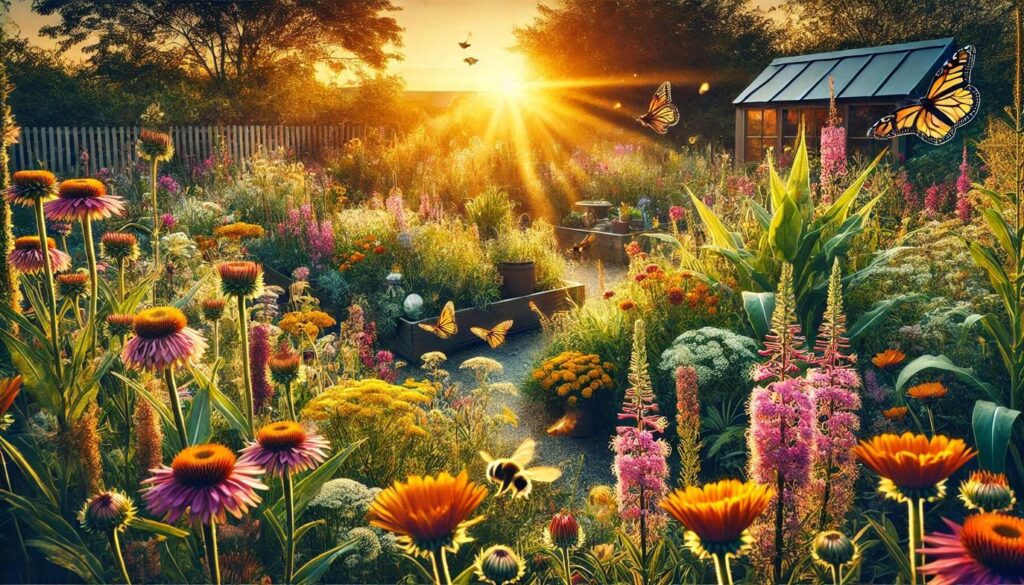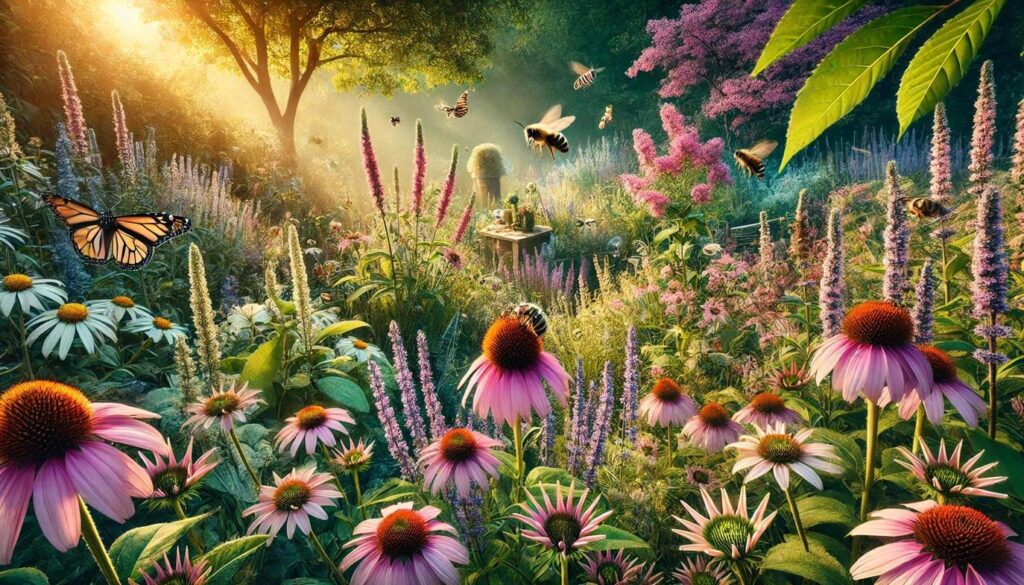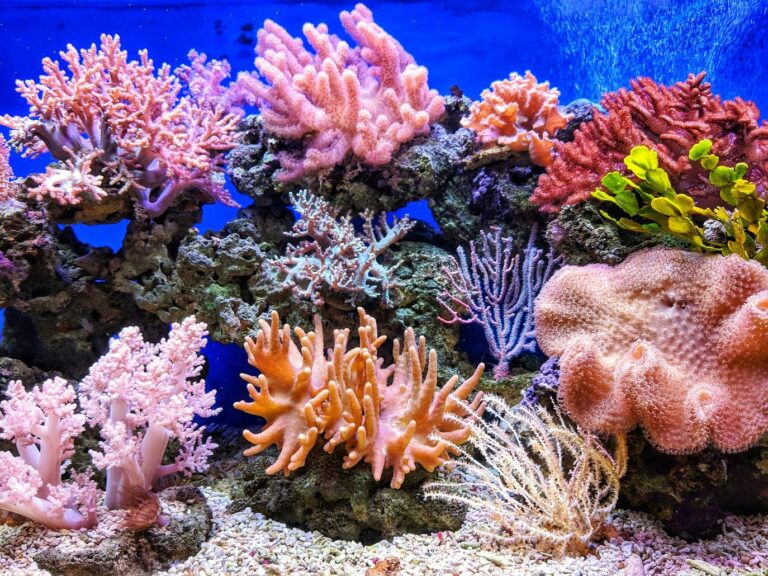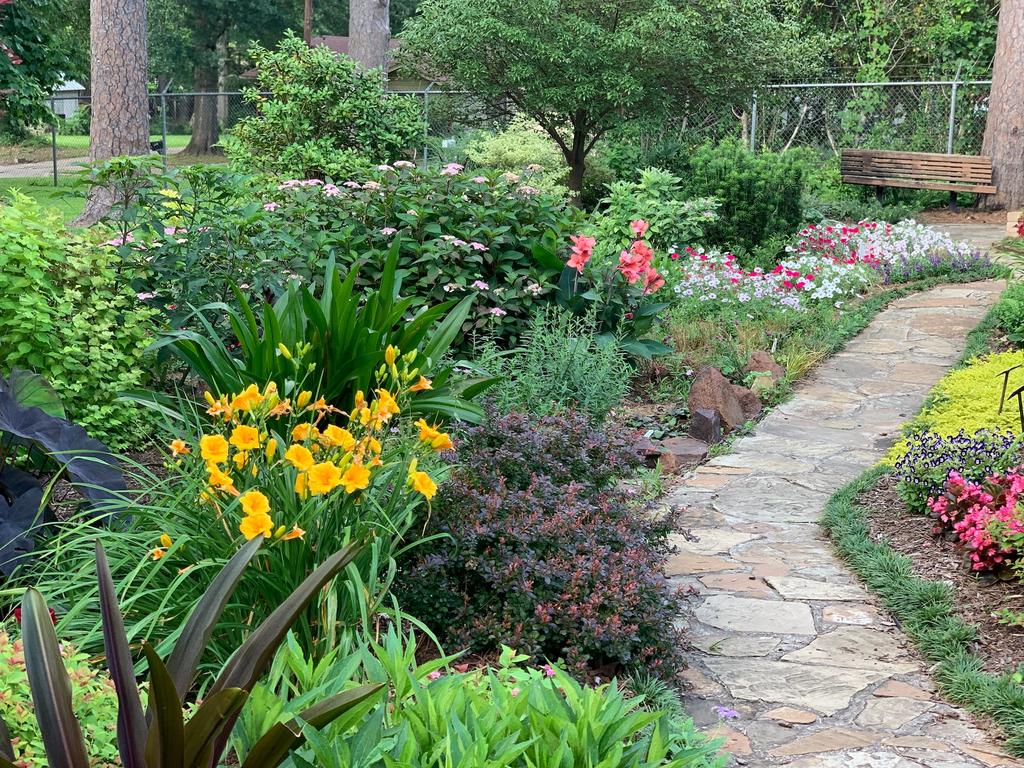Picture a garden buzzing gently with bees and alive with butterflies—a vibrant, eco-friendly sanctuary that supports wildlife. A place where colorful blooms paint a vibrant tapestry against a symphony of nature’s own making. This dream is within reach, and it starts with choosing the right flowers for your garden.
Gardening goes beyond leisure—it’s actively nurturing our planet’s health and biodiversity. These gardens act as sanctuaries of biodiversity, inviting the natural world back into our cities and neighborhoods. In understanding what flowers are best for the environment, we can help mitigate environmental impacts and support a more balanced ecosystem.
Green spaces are not just about aesthetics but about fostering positive change. Each flower planted becomes a beacon of hope, showing a commitment to environmental stewardship. This movement toward ecological responsibility isn’t just reshaping our surroundings—it’s threading us into the fabric of a healthier planet, one plant at a time. Engaging in eco-conscious gardening empowers us to be part of a solution that stretches far beyond our backyard fences, reaching into broader environmental efforts worldwide.
This guide explores what flowers are good for the environment and identifies the best eco-friendly plants for gardens. By carefully selecting plant species, we can transform our gardens into vibrant ecosystems that support local wildlife, promote biodiversity, and provide solace from our busy lives.
With growing awareness of environmental challenges, gardens increasingly serve as essential sanctuaries for sustainability and ecological balance. By incorporating eco-friendly flowers, gardeners not only cultivate beauty but also contribute to ecological balance and community well-being. Learn about the significance of sustainable gardening techniques, native plants for pest control, and which flowers are good for pollinators. Here’s how you can transform your patch of green into a beacon of environmental hope.

Blossoming with Purpose
Gardening isn’t just a pastime; it’s an act of stewardship for our planet. As we dive into the vibrant activity of gardening, each flower we select plays a part in creating a symphony of life—a harmonious melody that enhances both beauty and biodiversity in our environment. This is where eco-friendly flowers take center stage, offering stunning aesthetics and immense ecological benefits wrapped up in their colorful petals.
Your Flower Gardens Actually Help Pollinators
Pollinators such as bees, butterflies, and bats play a crucial role in plant reproduction, essential for environmental balance. More than just adding a flutter of life to our gardens, they are integral to maintaining the natural balance. According to the USDA, these tireless workers are crucial for the production of one-third of the foods we consume. However, their populations are declining due to habitat loss, pesticide use, and pollution.
The decline of over 3,600 native bee species in the U.S. directly threatens biodiversity, food supply, and agricultural stability. Yet, even from our home gardens, we can provide essential improvements by planting the right flowers that offer a lifeline to these tiny but mighty creatures—ensuring our ecosystems continue to thrive.
What Flowers Are Best for the Environment?
Native flowers, perfectly adapted to their local environments over centuries, provide dual benefits: they require minimal maintenance and serve as ecological linchpins. Able to flourish with even limited resources, native wildflowers ensure pollinators have reliable food sources and habitats. This unique adaptability allows them to play a critical role in maintaining environmental health and bolstering food security.
Why should we prioritize planting for pollinators? It’s simple—pollinator-friendly gardens protect ecosystems by providing essential habitats for wildlife. Integrating native flower species that evolved with local pollinators is one way that gardeners help protect these important animals from major environmental problems.
Community Advantages of Eco-Conscious Gardening
Eco-friendly gardening extends well beyond the confines of individual green spaces, fostering socioeconomic synergy. The Slow Flowers Movement champions locally sourced, sustainable blooms, reducing dependence on imported flowers that carry high environmental costs due to transportation and lower eco-friendly practices. Supporting local flower growers not only revitalizes economies but also minimizes the global environmental impact.
Moreover, by cultivating plants that support our local ecology, we empower communities economically and environmentally, aligning with broader sustainability goals. Initiatives like the USDA’s People’s Garden project showcase how communities can unite for pollinator-friendly gardening, accruing socio-economic benefits ranging from reduced pesticide use to generating local employment opportunities.
How Do Flowers Repel Garden Pests Naturally?
A thriving garden is more than a collection of beautiful flowers; it’s about creating relationships between plants that support each other naturally. Much like a symphony, where each note contributes to a beautiful harmony that keeps pests at bay naturally.
Top Pest-Repelling Flowers for Natural Garden Protection
Mother Nature holds an impressive arsenal up her sleeve when it comes to natural pest control. From vibrant marigolds to aromatic herbs like basil and lavender, there’s a plant to match almost every pest challenge—acting as nature’s own defense mechanism.
- Marigolds: Bright marigolds don’t just add visual appeal—they actively repel harmful garden pests like nematodes and flies naturally.
- They don’t just add color to your garden; they act as protective guardians.
- Lavender: The delightful aroma of lavender is not only a treat for humans but also a natural deterrent against pests like moths and flies.
- Its fragrant blooms irresistibly attract bees and butterflies, which are essential for maintaining a balanced ecosystem.
- Chrysanthemums: Known for their natural insecticide properties, chrysanthemums are all-around defenders, repelling everything from ants to bedbugs while doubling as a splash of vibrant color.
Companion Planting: The Art of Natural Garden Harmony
Eco-friendly gardening is about strategically pairing plants that mutually support growth and pest resistance. This technique, called companion planting, leverages the unique strengths of various plants to avoid harmful chemicals.
- Dynamic Duos: Pair basil with tomatoes—not only does the aroma repel tomato hornworms, but the tomato plant offers shaded shelter for thriving basil.
- Sage, rosemary, and lavender, combined, create a resistant and aromatic garden bed, keeping pesky insects at bay.
- Natural Pest Management: Allow your garden to double as a natural pest control zone.
- With the strategic use of nasturtiums and petunias, unwanted guests like aphids and beetles will feast on these sacrificial plants, sparing your main crops from damage.
- Creating a Harmonious Garden: Think of companion planting like a weekend potluck, where each dish brings unique flavors that enrich the meal.
- By carefully choosing plant pairings, you cultivate thriving, interdependent communities within your garden.
Proactive strategies contribute to a larger narrative—a testament to how simple gardening choices can echo across nature’s chorus. They invite us to reconsider our place within the ecosystem, planting seeds of change that promise to grow beyond the confines of our gardens. Feel free to share your eco-garden experiences and ideas with the community—what’s one plant pairing that has made a difference in your garden?

Step-by-Step Guide to Starting a Pollinator Flower Garden
Begin with Native Plants: The Foundation of Sustainability
Imagine beginning your green journey with the right footing by selecting plants that are native to your area. But why focus on native plants, you ask? Simply put, native plants are the unsung heroes of eco-friendly gardens. They have evolved over centuries to adapt to local conditions. This means they require less water, are more resilient to local weather, and are naturally resilient to local pests and diseases, making them a landscape’s best friend.
Native plants serve as essential support systems for the local pollinators—those buzzing bees and fluttering butterflies—by providing not just nectar and pollen but also habitat. For example, integrating native species like milkweeds and echinacea in your garden benefits native pollinators, which are vital for the environment’s ecological balance. Unlike exotic plants that might struggle in your local climate and require more resources, native plants have already adapted, naturally ready to thrive and flourish.
How to Plan Seasonal Flowering for Continuous Pollinator Support
To keep your garden buzzing with life all seasons, it’s essential to maintain a progression of flowering throughout the year, offering a continuous buffet for the pollinators. Just like a well-laid dining table entices guests to revisit, maintaining different flowering stages ensures bees, butterflies, and insects always have a reason to return and visit your garden.
- The Importance of Seasonal Planting: Incorporate at least three different flower species that can bloom in each season—from the earliest crocus and daffodils of spring to late-bloomers like asters that carry your garden’s life into the fall.
Establish Pesticide-Free Practices: Embrace Natural Defenses
Creating an eco-friendly garden is as much about what you don’t use as it is about what you do plant. Pesticides, chemicals used to kill unwanted insects, can be toxic to the very pollinators we aim to support. Instead, use nature’s own pest control systems—beneficial insects that naturally prey on pest species.
- Companion Planting: This age-old practice involves placing certain plants together to naturally ward off pests.
- For instance, marigolds can be grown with tomatoes to deter nematodes.
- Oftentimes, the right pairings can drastically reduce or replace the need for chemical interventions, allowing your garden, like a well-tuned orchestra, to regulate itself.
- Preserve Natural Habitats: Protect and incorporate
natural nesting sites—like bare soil and dead plant stems—into your garden to support pollinators year-round.- Excessive mulching can obstruct ground-nesting bees, so allowing some bare spots will invite these valuable pollinators to settle in.
Maximize Soil Health and Water Efficiency
Every gardener knows that the secret to a thriving garden lies in the soil, the unseen backbone of your gardening masterpiece. It’s like the rhythm section of a band—making sure everything stays on beat.
- Nutrient-Rich Soil: Use organic fertilizers and compost to enrich your soil.
- More natural approaches not only enhance soil structure but also promote the growth of beneficial microorganisms that help convert soil nutrients into a form plants can easily absorb.
- Water-Wise Gardening: Creating drought-tolerant gardens helps conserve water.
- Consider using organic mulches to keep soil moist, and opt for water-efficient irrigation like drip systems for optimal hydration without waste.
How Diverse Flowers Create Beautiful and Sustainable Gardens
A diverse assortment of plant life can transform your garden into a year-long visual delight and a supportive ecosystem. Imagine your garden much like a collage, filled with textures, colors, and heights, all coexisting harmoniously.
- Plants in Concert: Integrate both native flowers and companion plants, ensuring that your garden is both ecologically and aesthetically pleasing.
- Choosing blooms with varying shapes, sizes, and colors appeals not only to the pollinators but also to your eyes.
Creating an eco-friendly garden from the ground up is a commitment that pays back in biodiversity, sustainability, and beauty. It invites a chorus of pollinators, encourages balanced growth, and lays the foundation for a sustainable future.

Economic and Community Benefits of Planting Native Flowers
Supporting Local Economies and Reducing Environmental Impact
Gardening with a heart for our environment is akin to expressing love and gratitude for the world that nourishes us. It’s about making conscious, smaller choices in the garden that resonate like a harmonious note woven into the larger orchestra of life.
The Slow Flowers Society offers a tangible pathway, increasing awareness of how locally sourced flowers can bolster local economies. By opting for native blooms, you’re not just picking fresh and often more resilient plants but are also contributing to reducing the carbon footprint associated with transporting flowers across continents. The positive ripple effects are undeniable—support for local farmers grows, families flourish with local produce, and ecosystems thrive with reduced pesticide interference.
The Economic Upside of Pollinator Gardens
Eco-conscious planting isn’t just about saving the planet. Gardening mindfully is an economic boon, reducing the hefty price of pesticide use and boosting local agricultural economies. Pollinator gardens, especially when implemented on farms, lead to higher crop yields due to increased pollination rates as native bees find conducive environments.
Farms that integrate diverse wildflower plantings and companion planting enjoy a natural edge against pest infestations. They effectively reduce the need for synthetic pesticides—in turn, preserving a rich variety of species within the cultivated landscape.
Harvesting the Benefits: Beyond the Bloom
From a greater perspective, the movement toward local, sustainable gardening is a charm spell for socioeconomic revitalization. As eco-friendly horticulture makes its way into mainstream farming and gardening practices, communities are gradually experiencing their economic benefits.
- Economic Benefits: With consistently reliable yields, reduced pesticide expenses, and enhanced soil health, farmers adopting sustainable gardening techniques report significant financial benefits.
Cultivating Community and Economic Bonds
Every flower planted for ecological benefit holds the potential to knit community ties closer and strengthen local economies. How, you ask?
- Community Initiatives: Eco-friendly gardens often become community hubs, fostering cooperation, education, and local sustainability.
- Engage in local plant swaps and educational programs, where knowledge about companion planting and biodiversity can be shared, much like passing a melody through a musical ensemble.
- Educational Outreach: Programs like workshops and pollinator habitat tours supported by the Xerces Society embolden communities, nurturing eco-conscious generations who understand and act on sustainability principles.
By fostering these local and regional initiatives, we encourage a harmonious balance, wherein local gardens become symbols of economic and environmental renewal. Like the closing of a beautiful symphony, each community effort leaves a lasting, positive impression on our shared planet.

Cultivate Your Corner of the Earth
Imagine standing amidst a garden that dazzles with color and life, where each flower and native seed you plant weaves an intricate, life-sustaining melody connecting us to the rhythms of nature. When we reconnect with the earth through eco-conscious gardening, ripples of change help pollinators thrive—our planet’s quiet laborers who underpin our food systems and biodiversity. Cultivating flowers like nurturing nasturtiums and fragrant lavender, crafts patches of beauty where both humans and pollinators flourish hand in hand.
In the grand ensemble of life, every garden becomes a vibrant section of nature’s orchestra, harmonizing beauty, biodiversity, and sustainability. Every flower you plant contributes directly to the health and sustainability of our environment. By embracing eco-friendly initiatives—integrating native plants, reducing pesticide reliance, and inviting beneficial creatures—you help the environment reclaim its natural harmony.
Creating such a garden reflects a conscious act of nurturing both our environment and community welfare. It marks not just an aesthetic victory but also a commitment to sustainability and a stand against climate challenges and harmful agricultural practices. As you consider the blooms you choose, picture how they fit into your broader backyard tableau like a composer carefully placing notes to create a harmonious symphony.
Nurturing an eco-friendly garden not only serves as a beautiful escape from urban life; it also signifies a pledge to act responsibly towards our shared environment. This continuous act of cultivation echoes through our individual lives, fostering a closer connection to our surroundings and a symphony of sustainable choices that resound through our communities.
It’s a reminder that even small choices echo with significant positive impacts, reducing carbon emissions and supporting local agricultural ecosystems. Let your garden be a sanctuary that inspires connection with nature and enriches your daily life while fostering a symphony of sustainable choices resonating throughout our communities.

FAQ and Key Takeaways
1.What flowers are best for environmentally friendly gardens?
Focus on including native plants, as they support the local ecosystem and attract pollinators essential for biodiversity. Consider plants like coneflower and milkweed for great results.
2.Which flowers naturally repel garden pests?
Flowers such as marigolds, chrysanthemums, and nasturtiums repel harmful insects naturally, which can reduce the need for chemical pest control.
3.How do eco-friendly gardens contribute to sustainability?
Through the reduction of resource needs like water and pesticides, eco-friendly gardens support local pollinator communities, enhance biodiversity, and lessen environmental footprints.
4.How do I start an eco-friendly flower garden?
Focus on integrating native plants and companion planting techniques, avoid chemicals, and provide natural shelter for pollinators with elements like deadwood and leaf litter.
5.Can planting flowers really have an impact on my community?
Yes! By participating in local initiatives like the Slow Flowers Movement and the USDA’s People’s Garden projects, you’re actively nurturing both your garden and local community welfare.
6.Do I need a lot of space to grow flowers?
Not at all! You don’t need a large garden to grow beautiful flowers. With a bit of creativity, you can cultivate a stunning array of blooms even in small spaces. Consider container gardening or vertical gardens, which can thrive on a small balcony or windowsill. With the right choice of plants and a little care, you can create a vibrant, blooming oasis regardless of how much space you have to work with. Whether it’s a window box overflowing with colorful blooms or a cozy corner filled with potted plants, the beauty of flowers can thrive in any nook you have.
Key Takeaways
- Eco-friendly gardens are powerful allies in the battle against climate change.
- Flowers that naturally attract pollinators like bees and butterflies are vital for ecosystems and pollinator health.
- Native plants and companion planting strategies can significantly reduce dependency on harmful pesticides by naturally attracting pest-controlling insects.
- These practices are economically significant too, fueling local markets and contributing toward sustainable living ideals.

Be the Change: Join the Green Gardening Movement!
Why wait? Embark on your gardening journey today and let every seed you plant tell a story of hope and renewal. Join the eco-friendly gardening movement and be a catalyst for change in your community.
Let your garden be a source of inspiration—a symphony of color, life, and ecological harmony. Imagine your garden as a living testament to sustainable practice, where each flower whispers encouragement to bees, butterflies, and birds around us. Nurturing an eco-friendly garden means embracing our role as custodians of this Earth, extending responsible choices beyond the borders of our property lines and into a larger societal landscape committed to restoration and sustainability.
Together, we can harmonize with the earth and create a tapestry of vibrant, healthy, and flourishing life that sings a melody of hope and renewal for generations to come. Whether you’re a seasoned gardener, a budding enthusiast, or an eager beginner, every action, every plant, and every interaction with your garden resonates beyond the fences—so make it count. Share your journey with others and inspire those around you, be a glowing part of this growing movement. Let’s cultivate a greener world, one bloom at a time.




